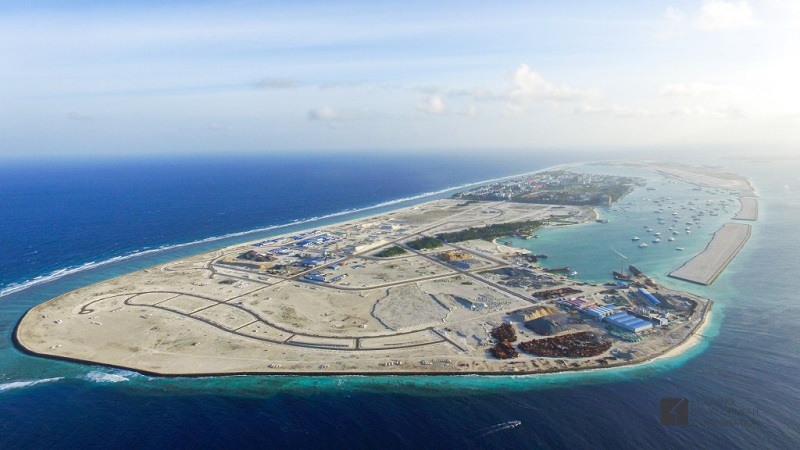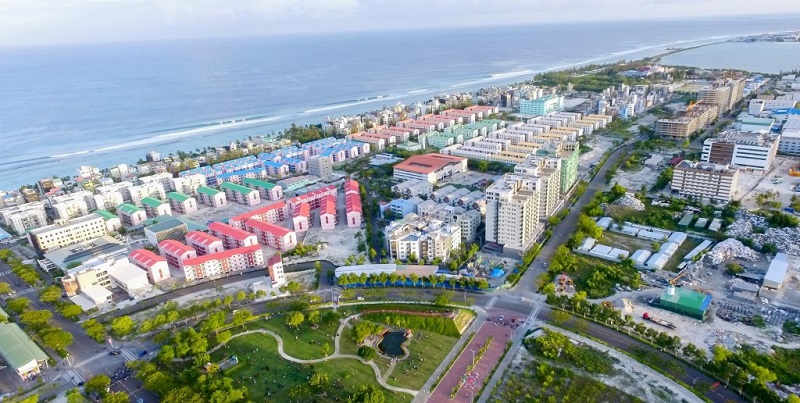Hulhumale - the city of hope
In February 2018, HDC (the Housing Development Corporation of the Maldives, the state-owned master developer of the new island city of Hulhumale) contacted the BRE regarding our potential involvement in assessing future developments there. A small delegation from BREEAM have returned from talks regarding further co-operation with HDC on this ambitious project.
Known mainly as a luxurious holiday destination for its white sands and turquoise waters, the Maldives is an island nation with thousands of years of history. An ancient trading hub between the Middle East, Asia and Africa, it’s culture and language are a blend of the civilisations that have landed on its shores. Beneath the seas, it also boasts one of the most diverse marine ecosystems in the world.
It is also a nation threatened by climate change. Over 80% of the country lies less than a metre above sea level – making it one of the most vulnerable countries in the world to rising sea levels [i], and rising sea temperatures continue to threaten its coral reefs and the rich ecosystems that depend on them.[ii]
Tourism forms the backbone of the economy, but the needs of luxury resorts and their guests puts pressure on a country with very few natural resources and one already dependent on imports. Although resort operators are mandated to provide their own power, sewage treatment and desalination, in a country known for its abundant sun, much of the country is still powered by industrial-scale diesel generators.[iii]
To address some of these issues in 1997 the government began the reclamation of a lagoon adjacent to Male. Deep sea dredgers poured millions of tons of sand onto the volcanic bed rock that would eventually form Hulhumale. Placed 2 m above sea level, it is designed to withstand the threat of rising sea levels.
Unlike the capital Male, where more than 150,000 people are squeezed onto an island less than one square mile, there are green spaces, public parks and room to breathe for the residents here.
Construction of Phase 1 is now nearly complete and will eventually become a community of 80,000 living in a master-planned city. Retail, education, community and leisure facilities are already creating a thriving society. Work on Phase 2 continues apace – with reclamation completed in only 77 days [iv], the first high density housing is now being constructed and this phase is set to become a focus for government, tourism and commerce.
Once complete, the City of Hope will accommodate 240,000 people, easing the significant population pressure in Male, giving two thirds of the country’s population access to new opportunities… and perhaps a sanctuary from the worst effects of climate change.
However, balancing the needs of economy, society and sustainability has not been easy:
- Planning and zoning regulations are regularly challenged by developers (accustomed to building right to the boundary of parcels of land), keen to maximise their financial gain.
- Holistic awareness of sustainability within the construction industry remains limited, and the focus remains on minimising capital cost.
- Establishing BREEAM where few standards exist for the minimum performance of buildings sets a high bar for new developments.
BRE's conversation with HDC continues. A follow-up tele-conference between HDC and the Strategic Advisory, BREEAM Communities and BREEAM International teams point towards the possibility for several potential solutions that together could address many of the challenges facing the sustainable development of Hulhumale:
- Discussions are taking place regarding the potential assessment of Phase 2 of Hulhumale under BREEAM Communities.
- The BREEAM International team will be providing support for the assessment of HDC’s first non-domestic BREEAM developments.
- The Strategic Advisory team, who have previously worked with the Brazilian government for the development of a social housing sustainability toolkit may have the opportunity to develop a tailor-made solution for social housing in the Maldivian context.
It is too early to tell what impact will be made, but BRE's hope is that one day the Maldives will gain international recognition not only for its natural beauty, but also for its sustainable built environment.
For more information on Hulhumale, visit hdc.com.mv/hulhumale/
References:
- [i] https://www.climatehotmap.org/global-warming-locations/republic-of-maldives.html
- [ii] https://www.theguardian.com/environment/2016/jun/01/coral-bleaching-spreads-to-maldives-devastating-spectacular-reefs
- [iii] http://www.environment.gov.mv/v2/en/news/6790
- [iv] https://hdc.com.mv/hulhumale/
This article was originally published here by BRE Buzz on 20 Sept 2018. It was written by Weikai Gong.
--BRE Buzz
[edit] Related articles on Designing Buildings Wiki
Featured articles and news
CIOB report; a blueprint for SDGs and the built environment
Pairing the Sustainable Development Goals with projects.
Latest Build UK Building Safety Regime explainer published
Key elements in one short, now updated document.
UKGBC launch the UK Climate Resilience Roadmap
First guidance of its kind on direct climate impacts for the built environment and how it can adapt.
CLC Health, Safety and Wellbeing Strategy 2025
Launched by the Minister for Industry to look at fatalities on site, improving mental health and other issues.
One of the most impressive Victorian architects. Book review.
Common Assessment Standard now with building safety
New CAS update now includes mandatory building safety questions.
RTPI leader to become new CIOB Chief Executive Officer
Dr Victoria Hills MRTPI, FICE to take over after Caroline Gumble’s departure.
Social and affordable housing, a long term plan for delivery
The “Delivering a Decade of Renewal for Social and Affordable Housing” strategy sets out future path.
A change to adoptive architecture
Effects of global weather warming on architectural detailing, material choice and human interaction.
The proposed publicly owned and backed subsidiary of Homes England, to facilitate new homes.
How big is the problem and what can we do to mitigate the effects?
Overheating guidance and tools for building designers
A number of cool guides to help with the heat.
The UK's Modern Industrial Strategy: A 10 year plan
Previous consultation criticism, current key elements and general support with some persisting reservations.
Building Safety Regulator reforms
New roles, new staff and a new fast track service pave the way for a single construction regulator.
Architectural Technologist CPDs and Communications
CIAT CPD… and how you can do it!
Cooling centres and cool spaces
Managing extreme heat in cities by directing the public to places for heat stress relief and water sources.
Winter gardens: A brief history and warm variations
Extending the season with glass in different forms and terms.
Restoring Great Yarmouth's Winter Gardens
Transforming one of the least sustainable constructions imaginable.



























